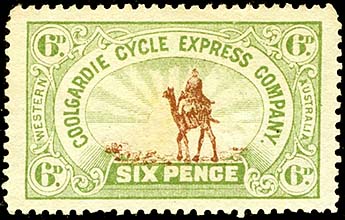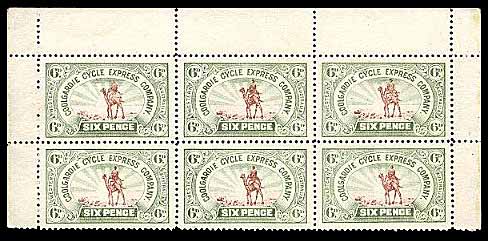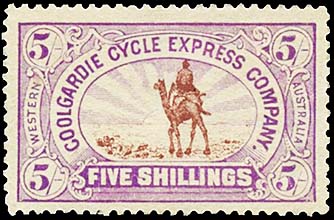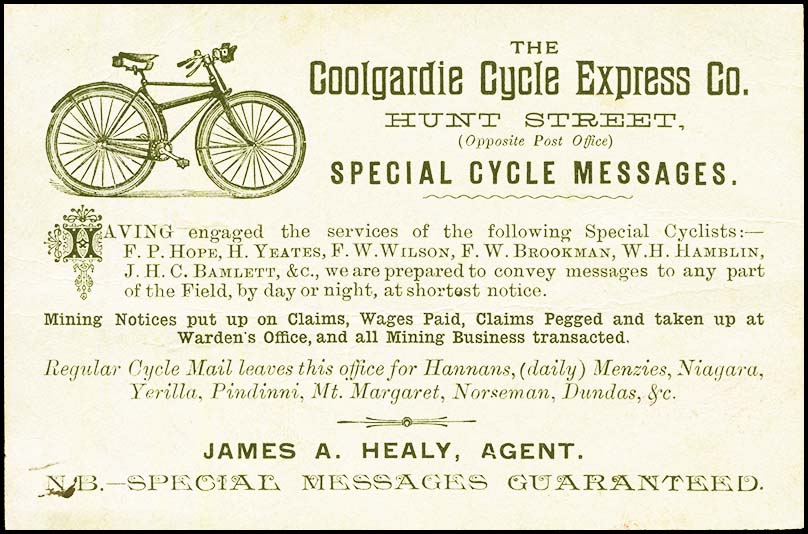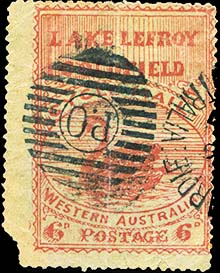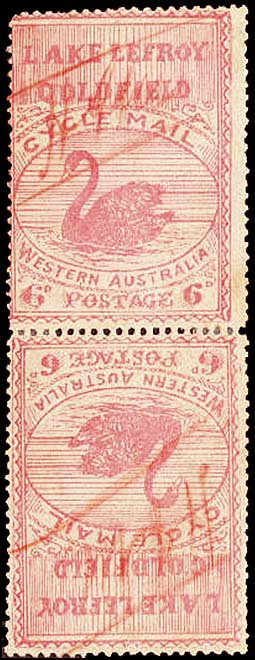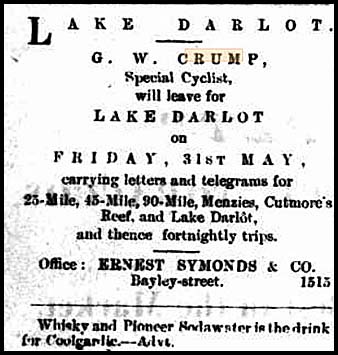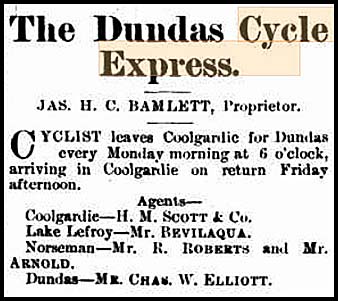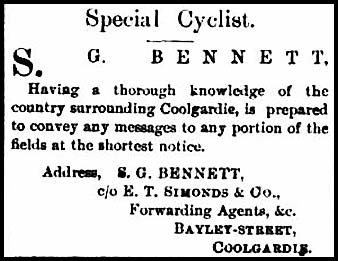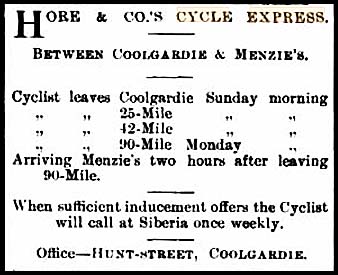The Cycle Express Companies in the Goldfields.
- Australia 1901-1988
- New South Wales
- Queensland
- South Australia
- Tasmania
- Victoria
- Western Australia
- International
- Special aspects
The Cycle Companies on the Goldfields are presented as follows:
- The Coolgardie Cycle Express.
1.1: Operation.
1.2: Destinations.
1.3: Closure.
1.4: The rates.
1.5: The 1893 stamp issue and variations.
1.6: The 1895 stamp issue. - The Lake Lefroy Cycle Mail of Kalgoorlie.
2.1 The stamp and variations. - Other Cycle Post Companies on the W.A. Goldfields.
In 1892-94, telegraph lines were starting to be constructed to Coolgardie in the Goldfields. Other lines to other Goldfields were also being constructed including:
- to Cue and Mount Magnet in the Mid West region;
- to Southern Cross and to Pingelly to Wagin in the Wheatbelt;
- to Marble Bar, Bamboo Creek and Nullagine in the Pilbara.
All of these lines were servicing , in part, the newly discovered goldfields. At that time, all the goldfields were looking promising but the W.A. Colonial Government had limited funds. It was therefore difficult to be able to select those areas with the highest priority and to fund all their activities including the construction of Telegraph Lines, construction of Railway Lines as well as attend to health matters (e.g influenza, scarlet fever, tuberculosis, etc) and legal requirements.
As Coolgardie grew through the rich deposits around it, the Government could do only so much - and even that amount was hampered by individuals in high places with little experience in planning, management or finances.
Enter the private sector. Some of the most pressing requirements for the isolated mining centers included distributing news, newspapers, telegrams, a wide variety of legal documents for registering and operating the mines, etc. The postal services were able to meet some - but far from all of the requirements expected of them. In addition, the services were not always a safe carriage for many articles.
Two main companies were founded on the inability of the Post and Telegraph Office to deliver letters and telegrams with a number of smaller ones. These are discussed below.
Cycling as a sport and business.
In the mid-1890s, cycling was a very popular past-time and sport. Road races were held in many parts of Western Australia. The Commissioner of Police was even considering a proposal that senior police officers might be supplied with bicycles to facilitate their work and enable them to visit constables on duty several times each night rather than just once or twice. Indeed cycling was so popular that in July 1896:
"Speaking at a service at Portsea, the Bishop of Guildford (Dr. Sumner) recently said he feared that the cycling craze took a good many from church. It must not be supposed that he was not in favor of cycles, but they were a temptation to some to absent them selves from the parish church on Sundays. Cyclists might say that they worshipped the God of nature, but God was a God of revelation as well. The bishop urged the congregation not to miss the opportunity for common worship"
(Inquirer 17 July 1896) .
Newspapers frequently printed accounts of cycle events and the latest equipment. An excellent example is that printed in the West Australian 1 January 1899. That report also notes some of the successes on Dunlop tyres including James Healy winning the one mile championship.
1. The Coolgardie Cycle Express.
The formation of the Coolgardie Cycle Express Company was the work of Mr. James A. Healy. In 1893, he created the company and enlisted the services and assistance of a number of well-known and expert cyclists (including F. P. Hope, H. Yeates, F. W. Wilson, F. W. Brookman, W. H. Hamblin and J. H. C. Bamlett). At that stage, the telegraph line to Coolgardie had not commenced construction - it was not until February 1894 that work commenced to extend the line beyond Southern Cross.
A formal Notice of Intent to register the company is shown below:
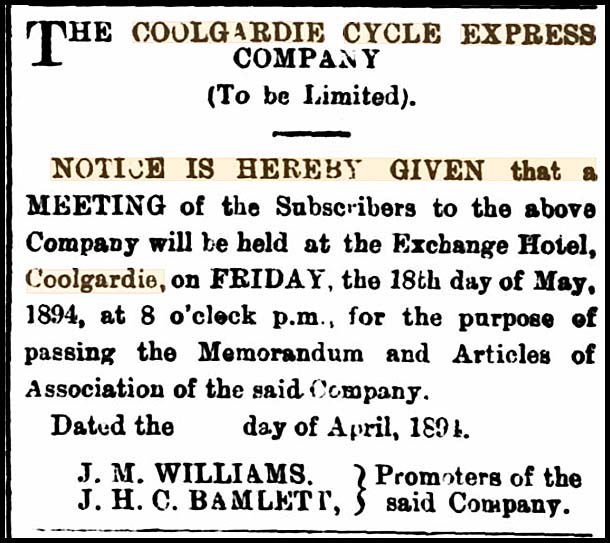
The Western Australian 10 May 1894.
The Notice of Intent to hold a meeting and formalise a Company which appeared in
several outlets
.
Unfortunately, the Express and Telegraph of Adelaide reported, on 7 August 1894 (about a month after the telegraph line reached Coolgardie):
"The Coolgardie Cycle Express Company has gone into liquidation owing to the opening of the telegraph line which interferes very much with its business".
But wait - there is more: the Coolgardie Miner of 18 August 1894 noted
"Our readers and the public generally will be pleased to hear that the good work hitherto performed by the Coolgardie Cycle Express Co., Ltd. (now in liquidation), in opening up and maintaining communication with the outer centres is not to be allowed to lapse. As will be noticed on reference to our advertising columns, a new company has been formed, having for its objects the undertaking and prompt dispatch of all express message and other business between the various mining centres, camps and rush as on tho field.
The services of the best cyclists, including Mr. J. H. C. Bamlett and other cracks have been secured and we trust that the new company, by executing all business entrusted to them promptly and efficiently, will earn that confidence and patronage from the public which their enterprise certainly deserves. Full particulars as to terms, timetables, etc., may be had on application to the agents, Messrs. O'Driscoll. Scott & Rebbeck".
The Mount Gambier Border Watch of 15 August 1894 provided information about the speed of the cyclists:
"A West Australian journal remarks that it is due to the Coolgardie Cycle Express Company and also to Mr. J. H. C. Bamlett (formerly captain of the Geelong Cycling Club), that the following ride should be presented to the public, it being the record for the journey. Mr. Bamlett started from Southern Cross at 6.15 a.m. on the 5th of June and arrived at Coolgardie at 9.55 p.m. the same day. Besides the despatches, he carried a packet containing a watch, sealed by a Government official at Southern Cross, and addressed to Mr. Finnerty, the warden at Coolgardie, who certified the time of arrival to be 9.55 p.m., showing that the distance of 120 miles had been accomplished in 15h. 40min. The actual riding time was 11h. 40min. All who know the rough waggon-track and have seen the miles and miles of sandy plain will recognise Mr. Bamlett's achievement to be a "remarkable feat".
"We notice that our town canvasser and collector, Mr. J. A. Healy, has removed his office from Bayley Street to Hunt street (DeBaun's corner) opposite the Post Office, where he will continue to carry on his land, mining and commission agencies - also his business in connection with the Coolgardie Cycle Express Company" (Coolgardie Pioneer 10 July 1895). In September 1896, "The Coolgardie Cycle Express Company as represented by Mr. James Healy, is now located in No.10 Bayley Chambers".
It appears as if the business might have been operated as a type of "franchise agreement". The Coolgardie Pioneer of 3 July 1895 reported "Mr. J. Healy commission agent, reports the sale of the goodwill of the cycle service between here and Dundas, lately carried on by Mr Bamlett, to Messrs Miller and Kilminster, who will run under the name of the Coolgardie Cycle Express".
The Post and Telegraph Office opened in Coolgardie in July 1894. It was then in competition with the Cycle companies in terms of servicing the fields around Coolgardie and soon after around Kalgoorlie.
The original advertisements showed the work which was on offer: "we are prepared to carry messages to any part of the field, by day or night, at shortest notice. Mining notices put up on claims, wages paid, claims pegged and taken up at Warden's Office and all mining business transacted".
The initial advertising for the company listed the following destinations:
Regular cycle mail leaves this office for Hannans (daily), Menzies, Niagara, Yerilla, Pindinni, Mt. Margaret, Norseman, Dundas"
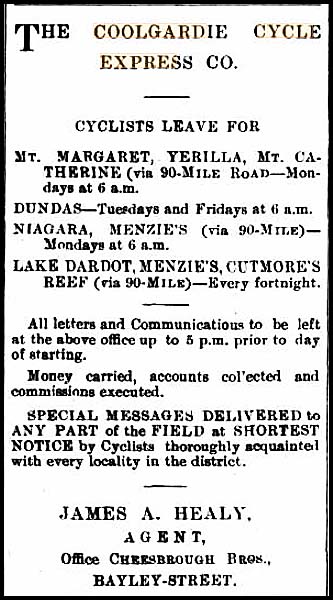 |
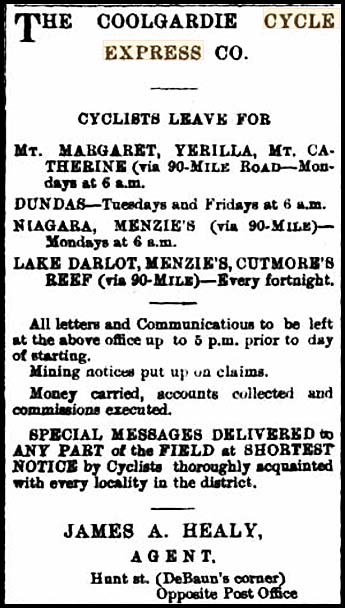 |
| Coolgardie Miner 3 July 1895 - an advertisement appearing daily. Address is in Bayley Street. |
Coolgardie Miner 14 September 1895. Address in Hunt Street - Opposite the Post Office. |
Hannan's Herald of 27 September 1895 reported:
"In order to meet the desires of the leading trades people and brokers who have daily business transactions with Hannan's, Mr. Healy, of the Coolgardie Cycle Express Company, has made arrangements to run a daily cyclist to and from that rapidly growing centre and will make up a daily mail at each place.
It is assumed that the messages can be taken from here and replies brought back under five hours and brokers will do well to subscribe to the movement as they can then get their business transacted much more speedily than by using the electric telegraphs. Start is contemplated early in the coming week".
On 4 October, the previous announcement was followed with "The special cycle mail to and from Hannan's daily, will commence on Monday next and those desirous of doing business promptly, will leave their letters and communications with Mr. Healy at the office of the Coolgardie Cycle Express Coy" (Coolgardie Miner).
By October 1895, delays in telegraphic communication were making the locals feel quite exasperated. The Chronicle Adelaide wrote "There is not yet telegraph communication with Norseman, messages, letters and papers being taken to Coolgardie by cycle express. Even in Coolgardie, while the the telegraph 'block' has been at its height, telegrams have come through very slowly and some of the more enterprising spirits talk of establishing a service of carrier pigeons between there and Adelaide".
Further north, a telegraph office was erected at Menzies in November 1895. The Coolgardie Pioneer addressed the gain and loss to the people of Menzies as follows:
"The residents of Menzies, while rejoicing at the facilities afforded by the extension of the telegraph wire, new postal accommodation and a bi-weekly mail service - with two coaches per week from and to Coolgardie - regret that they are to lose the services of Mr. Watling of the firm of R. T. Hore &. Co., cyclists of Coolgardie. This gentleman has always been most obliging, painstaking, and ever ready to undertake every duty, no matter how arduous, that in his opinion would benefit the community.
Under many an adverse circumstance, he has always been very punctual in bringing messages and indeed (though want of telegraph messenger) people could get their messages formerly quicker by Mr. Watling than they now can by wire. Very frequently he occupied only ten and twelve hours on one journey and people could depend on getting their messages delivered at their places of business or on the mines within an area of a few miles within 14 hours, whereas now a telegram may lie in the office for five, seven or ten days. Indeed, there are five wires lying in the office for one man who is out about 2½ miles and may remain there probably until Christmas.
There is a probability of Mr. Watling running between here and the north-eastern parts as a special cyclist and, should he consent to do so, all will rejoice as he is a thoroughly reliable cyclist and one who can be thoroughly relied upon to do his duty to those who employ him".
On 20 August 1896, the Goldfields Morning Chronicle announced a new route to be tried: "A special cyclist will leave the Coolgardie Cycle Express Company's office, Hunt Street, at 6 p.m. today for Mt. Margaret via White Feather, Hayes's Find etc".
At some stage in 1897, the company also included camels as another mode of transport on routes for which conditions were unsuitable for bicycles or when total deliveries being carried were too weighty.
A great story was printed by the Sunday Times on 26 February 1922:
"In Perth last week was Billy Bamlett, the hero of as fine an early gold-fields story as was ever reeled off William Clare's printing press in the "Coolgardie Miner" office.
Bamlett was one of the famous Cycle Express men (these including the present Percy Armstrong), who used to take out (often on spec) telegrams and cables to new and old shows in the mulga and other non-adjacent parts. Often a cable would be lying in the telegraph office at Coolgardie and, by some means, the Cycle Express men would hear of it and know it contained an offer for a mine, the good news of a flotation in London, or similar messages.
Then, on their own responsibility, one of the fliers would take the message, whizz out, or perhaps have to push his bike half way, and deliver the cable. Sometimes they got nothing if the coded cable showed the float to be a failure. But often £50 and £100 have been paid to the cyclist for good news. Once a bikist who brought out good news 75 miles got a parcel of original paid-up scrip that eventually landed him in £750 within a year!
Bamlett went once down to Widgiemooltha, (then Wigemoola) and, according to his story in the "Miner", when returning over Lake Lefroy was chased by savage dingoes! He tucked his head down and put on a spurt over the flat, dry salt lake and got a lead of about 400 yards. But when he came to gravelly - and eventually to loose soil - the persistent brutes (according to Bamlett) leaped and snapped hungrily at him, once nearly pulling him off the bike.
On reaching another flat stretch and getting ahead 250 yards, and knowing that soft, uphill country lay ahead, he leaped off, undid his tool-kit, pulled out a new nickel-plated spanner, and presented it to the advancing mob. They stopped dead, turned tail and disappeared with a disappointed howl. One of their number, the leader of the pack, had been shot dead a week before by a cyclist carrying a nickel-plated revolver!
When Bamlett had told his hair-raising, blood-curdling yarn, in the "Miner" the following week a skit in verse appeared. This is the concluding verse:
"When the Light Brigade Charge no more has a place,
And Trafalgar has died from our lingo,
Still shall live in our annals that bicycle race
When Bamlett defeated the dingo!"
Mr. Healy retired to pursue other commercial activities in December 1896 - after the Postmaster-General declared the stamps to be illegal and that, before the end of 1896, he had no knowledge of their existence. Some arguments proffered by senior Government officials have always been hard to defend. In this situation:
- the advertisements such as shown above informed readers the Cycle Express Office was "opposite the Post Office". Indeed it was visible from the window of the District Postal Inspector.
- the Post Office frequently used the Cycle Express services for delivery of mainland telegrams to the fields.
The last route to be serviced was therefore closed.
There are some (very few) covers with their obliterating handstamp dated in 1897. Hence some of the service appears to have been maintained in some way.
Rates for delivery depended on the distance the article had to be carried. Both letters and telegrams were carried at rates ranging from 6d to 1s.
1.5: The 1893 issue and variations.
When the cycle express services were first formed, no stamps were issued. All letters were prepaid and handstamped PAID.
Special company stamps were first printed in 1893. These were blue coloured rectangles with a white space in the centre showing a bicycle. Two values were printed - 1s and 2s 6d - and these figures appeared below the bicycle. The inscription "Coolgardie/ Cycle Express/ Company/ Cycle Messages" surrounded the central design. The stamps were printed:
|
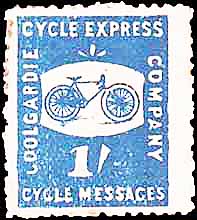 |
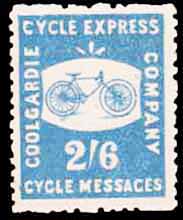 |
| When used, these stamps were cancelled with a steel stamp (in violet ink) showing 'Per. Coolgardie Cycle Express Co., Hunt Street'. |
||
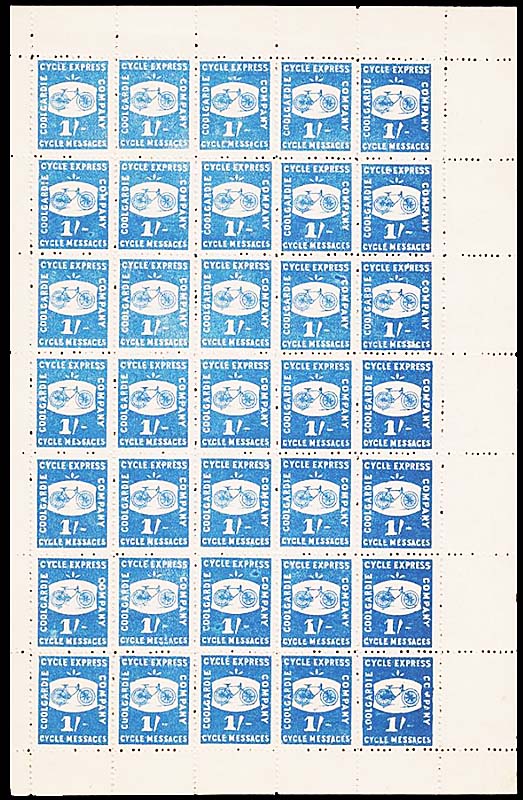 |
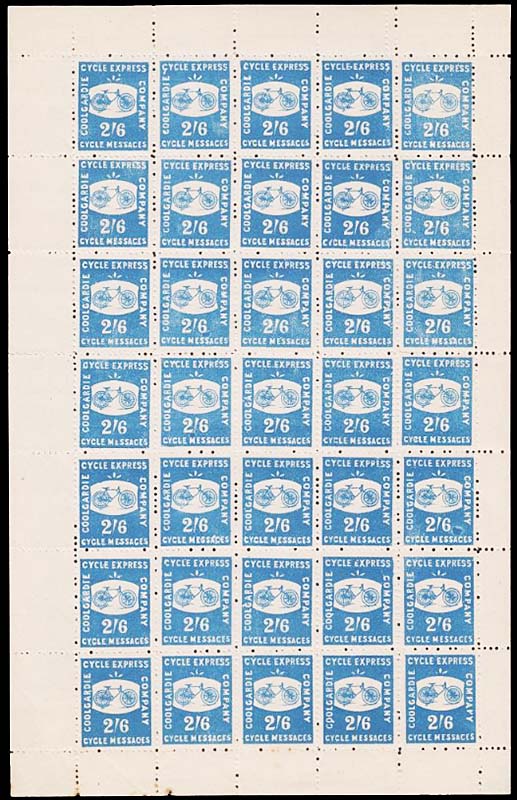 |
|
2/6 blue Coolgardie Cycle express showing a complete sheet of 35 stamps. |
The major items recorded for these two blue stamps are:
- sheets with no perforations between two rows or at the base;
- the right 2 columns with selvedge on three sides and imperf between rows 2 and 3 (1/-) and rows 4 and 5 (2/6);
- block of 6 (1/-) imperforate at right;
- marginal single stamps (1/-) imperforate at right Corinphila Sale 297, December 2022, Lot 10503) or at the left;
- blocks of 4 stamps double perforation at right;
- vertical strips of 5 (both denominations);
- blocks of 4
Covers with the blue stamp are known but are very rare:
| 2/6 blue | Posted at Broken Hill (N.S.W.) and delivered to Kalgoorlie in 1895. Bears the blue 2d emu N.S.W. Centennial stamp and a 2/6 blue Coolgardie stamp to pay postage cost from Coolgardie to Kalgoorlie. |
In late 1895, a second supply of stamps was printed. The design for this issue showed a camel and rider travelling across the desert with the setting sun in the distance. The set of stamps comprised three values - 6d. (in green), 2s (in yellow) and 5s (in mauve). These values appeared in figures in each corner and in words at the foot of the design. They were inscribed "Coolgardie Cycle Express Company" with "Western Australia" at the sides. This second set of stamps were printed:
|
|
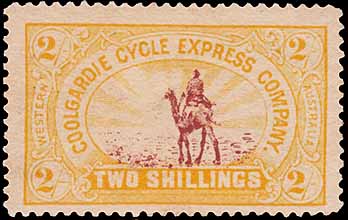 2/- yellow. |
Stampboards Post |
Abacus Auctions # 3 |
The major items recorded for these three "camel" stamps are:
- a marginal mint block of 6 four the 6d denomination;
Covers with the Camel stamp are known but are very rare. The known covers are:
| 2/6 yellow | Posted at Broken Hill (N.S.W.) and delivered to Kalgoorlie in 1895. Bears the blue 2d emu N.S.W. Centennial stamp and a 2/6 blue Coolgardie stamp to pay for its carriage from Coolgardie to Kalgoorlie. |
An article in the Stamp Collector (reprinted in the Sunday Times of 12 August 1934) notes, in addition to other interesting details especially about known covers, the following stamp counts:
| Issue | Denomination | Printed | Remainder (approx) |
| 1893 issue | 1s | 500 | 135 |
| 2s 6d | 500 | 135 | |
| 1895 issue | 6d | 2,000 | 350 |
| 2s | 12,000 | 300 | |
| 5s | 1,000 | 280 |
An advertising card was also printed about the same time as the Camel stamps were issued:
On the reverse side of this card, five rectangular whitish marks can be clearly seen.
They indicate that all five stamps (bicycles and camels) had been fully affixed to the reverse side but later (unfortunately) removed.
The rush to the Lake Lefroy goldfield began in 1892. Its seen by the locals as being a positive development because "it cleared Coolgardie of the surplus unemployed".
A cycle line from Coolgardie and from Kalgoorlie to the Lake Lefroy goldfield was formally established by Messrs. Hillier and Maskell by April 1897 - about three months after the Coolgardie Cycle Express company had stopped trading. It seems to have actually operated informally from about November 1896. It began by carrying newspapers but almost immediately also carried letters and telegrams.
The nearby Post and Telegraph Office at Widgemooltha did not open until 18 October 1897 - so there was indeed a hiatus period. The Lefroy operation (for reasons which thankfully defy history) soon issued its own stamps.
2.1: The stamp issue and variations.
The Lake Lefroy cycle stamps were:
|
|
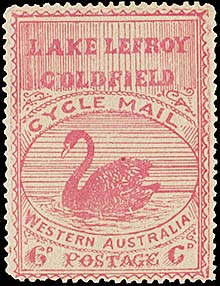 Unused. Abacus Auctions 243, March 2021, Lot 706. |
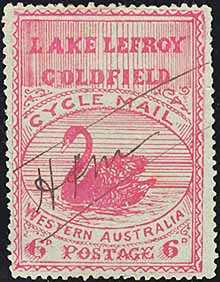 Used. Cancelled with signature H & M. Stampboards. |
|
|
The Clare's Weekly of 19 November 1898 reported:
"Philatelists will envy the lucky possessor of the cycle mail stamp from Western Australia. It is indeed a unique curiosity, for there is but one cycle mail in the world.
The original design is somewhat rough but not the less interesting for that reason. The description of the stamp is as follows:
First, on a ground lightly shaded with perpendicular lines, are the words "Lake Lefroy Goldfield". Then, in an oval, is presented the black swan of Australia with the words "Cycle Mail" above it and "Western Australia" below while at the bottom under the oval are the words "6d Postage 6d". The color is pink stamped upon a pale green ground".
The stamps were affixed to letters, the usual method of cancellation being by pen with three lines and "Coolgardie" with" initials. Given the above reference, this Lake Lefroy stamp, like the Coolgardie Cycle Express stamps, constituted an illegal issue of the "local" stamps. Nevertheless, letters from Lake Lefroy to places beyond Coolgardie or Kalgoorlie bore both "local" and postage stamps when sent through the post. Occasionally a local stamp is recorded to have part of the postmark of one of the post offices.
The Lake Lefroy cycle stamp was only in use for a very short time - the service stopped after four months at the end of February 1897 when the Government provided a mail service.
The Lefroy stamp is much rarer than the Coolgardie stamps. About 20 examples might exist but some dealers put that number at only 5.
Three singles are shown above plus the tête-beche pair.
No covers are recorded but some stamps have part of a Coolgardie date stamp - as is shown above.
3. Other Cycle Post companies on the W.A. Goldfields.
Other smaller Cycle Express companies operated on the Goldfields around Coolgardie and Kalgoorlie including:
CYCLE EXPRESS TO LAKE DARLOT. Leaves Coolgardie MONDAY, 27th inst., for 25, 42, 45, 90-Mile, Menzies and Lake Darlot. Special Messages taken to Mt. Catherine and Mt. Margaret. All letters and communications to be left at the office of The Coolgardie Cycle Express Co. J. A. Healy, Agent. |
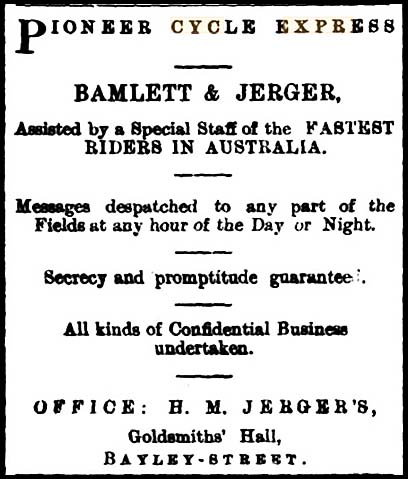 |
| The Coolgardie Miner of 23 May 1895. | Coolgardie Miner 14 September 1895. Bamlett is one of the listed Proprietors (third company). |
In a section of the Coolgardie Pioneer of 4 September 1895 devoted to comments from the public forerunner of electronic social media!!, "bicyclists can deliver messages between Hanna's and Coolgardie more quickly than the Telegraph Department".
The Goldfields Cycle Agency Company, Limited, Hunt Street, Coolgardie was registered with the Office of Companies during the week ending 24 June 1897.
All manner of other things were regularly advertised including:
- CAMELS CAMELS. CAMELS - Cared for in the BEST STYLE, FIVE SHILLINGS PER DAY.
- THE COOLGARDIE BEDDING FACTORY, BAYLEY STREET, Next to Marvel Bar, Is prepared to supply Mattresses, Pallidnesses, Bolsters, Pillows, etc., at Perth prices.
- T H E A T R E ROYAL. An ASSEMBLY will be held on WEDNESDAY NIGHT, MAY 29, Commencing at 8 p.m. and ending at 11.30. Admission: Gentlemen, 5s. Ladies Free, by Invitation.
